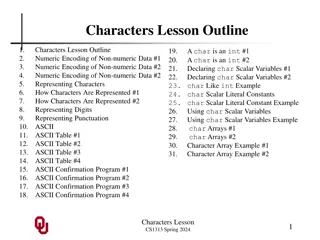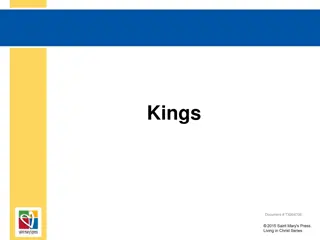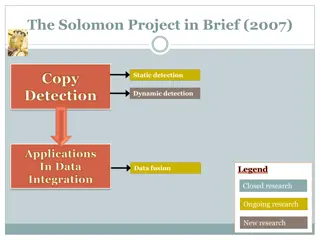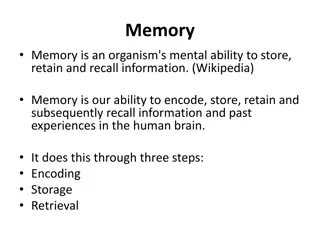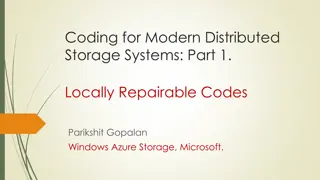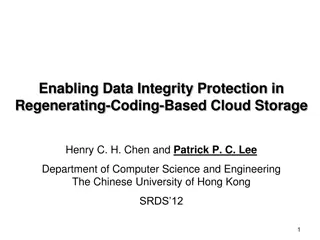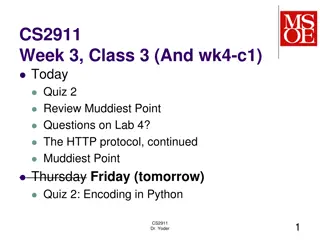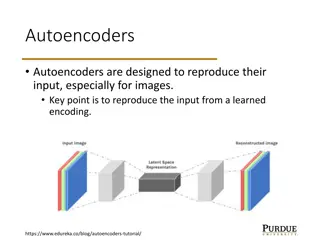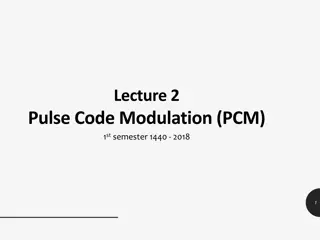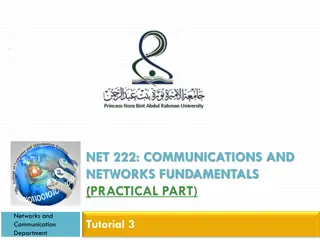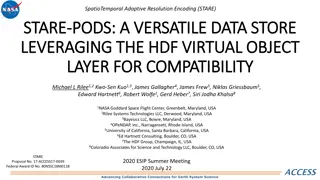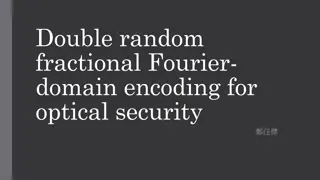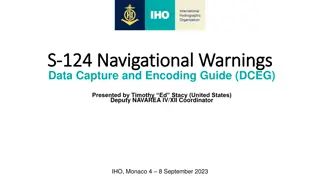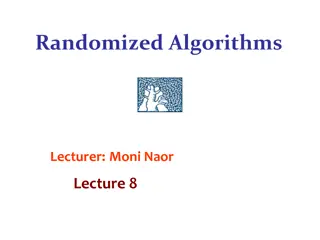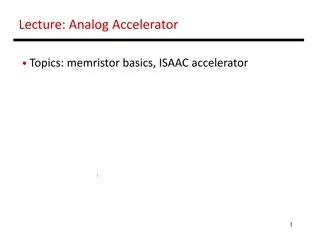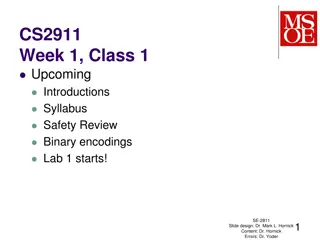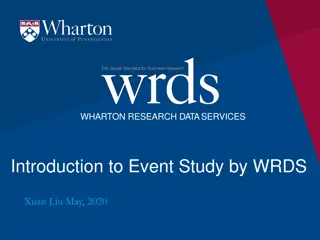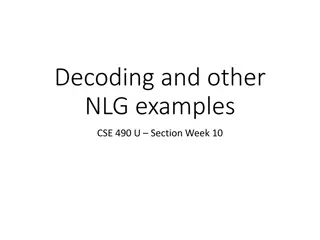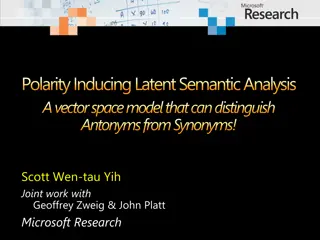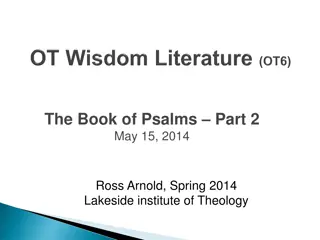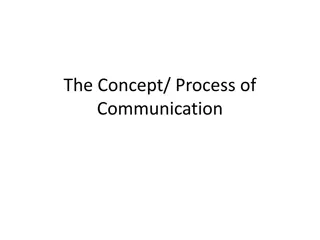Understanding Reed-Solomon Encoding: Basics and Applications
Messages consist of symbols from an alphabet and can face erasures and errors during transmission/storage. Redundancy is introduced in codewords to handle these faults, with schemes like 2x and 3x redundancy. Parity bits help detect/correct errors in binary messages efficiently, offering a cost-effective solution compared to high redundancy. Reed-Solomon Encoding provides a powerful error-correction technique widely used in various communication systems.
Download Presentation

Please find below an Image/Link to download the presentation.
The content on the website is provided AS IS for your information and personal use only. It may not be sold, licensed, or shared on other websites without obtaining consent from the author. Download presentation by click this link. If you encounter any issues during the download, it is possible that the publisher has removed the file from their server.
E N D
Presentation Transcript
How Reed- Solomon Encoding Works by Thomas Manning
Messages Messages are strings of symbols, i.e. "001010", "Hello, World", or "0xDEADBEEF". The symbols come from a set of elements. Also known as an alphabet. Notationally we'll use " ". A string of K symbols is represented as K. Binary strings have = {0, 1}. With this, a byte can be thought of as 8 Messages with a single byte as their symbol (i.e. bytestrings) would have = {0, 1, ..., 255}. An int64 is 8when is a byte.
Erasures and Errors When a data is transmitted/stored, two types of faults can occur: Erasure: A known loss (or corruption) of a symbol. You know the position of the fault. Example: An HDD/SSD dies, but we know it's unavailable and what symbols it was supposed to store. Example: A physical encoding where a voltage of -1 is "0", 1 is "1" and 0 is "missing". Error: An unknown corruption of a symbol. You do not know the position of the fault. A bit flip. A scratch on a CD causing a mis-reading.
2x Redundancy A basic scheme for handling errors and erasures: redundancy. We take a message and modify it to form a "codeword" which is what we store/transmit. If we repeat every element twice, we can: Correct one erasure per symbol, because we have 2 copies and we know which one is good. Detect one error per symbol, because we know there is a mismatch (but we don't know which is wrong). Message Codeword w/Erasures w/Errors ABC AABBCC A__BC_ ABABCA ABABCA
3x Redundancy What if we want to also correct errors? We need more redundancy! If we repeat every element thrice, we can: Correct two erasures per symbol, because we have 3 copies and we know which ones are good. Correct one error per symbol, because we can see there is a mismatch AND we can pick the most common symbol (i.e. "A" if it's "AAB"). Detect one XOR two errors per symbol (2 if the errors go to different symbols). Message Codeword w/Erasures w/Errors ABC AAABBBCCC _A___BC__ AABAABCAB
The Problem with Redundancy It's expensive. Can we achieve something similar but with less additional data?
Parity Bit For binary messages, we can XOR all the bits in the message and get one extra "parity" bit. With this we can Correct a single erasure in the message by XORing all the other bits (including the parity) together. Detect a single error per message by repeating the process and seeing if the parity matches between what's received and the calculation. Message Codeword w/Erasures w/Errors 0101 01010 0_010 11010
Generalizing Parity Can we have more than one parity bit? Does parity work for non-binary messages? Can we find a code that adds the least number of symbols to correct a given number of errors/erasures? YES! But first, some theory...
Linear Block Codes Injective Mapping: C: K N : An alphabet (set of symbols); | | = q. K: A string of K symbols from . K= "message" ; N= "block" or "codeword" Example: Message Codeword = {a, b, c} abc abca = map a 0, b 1, c 2 sum modulo 3 unmap and append result to message ex. abc (0 + 1 + 2) % 3 = 0 = a: abc abca abb abbc bab babc cca ccab
Mappings Mappings have three sets: Domain, this is the set that is mapped from. In our case, it's the set of all possible messages or K Co-Domain, this is the set of possible elements that could be mapped to (but aren't necessarily). In our case, it's the set of all possible codewords, or N Range, this is the non-proper subset of the co-domain that is mapped to. In our case, it's the set of codewords actually mapped to. Injective means that: Every element in the domain is mapped from Not necessarily every element in the co-domain is mapped to. Which is the same as saying the range can be smaller than the co-domain.
Simple Parity Coding Co-Domain Domain Range 000 000 00 001 011 011 01 110 010 11 101 110 10 Actually Mapped Codewords 111 All Possible Messages 101 100 Possible Codewords
Correcting Erasures We can correct an erasure by ignoring the erased symbol in the codeword and every codeword in the range and seeing if there is a single match.
Simple Parity Coding - Erasure Received Codeword Co-Domain 0_1 Domain Range 000 000 00 001 011 011 01 110 010 11 101 110 10 111 101 100
Hamming Distance Distance( K, K) -> The substitution-only distance between two strings Distance(abc, abc) -> 0 Distance(abc, aac) -> 1 (in position 2) Distance(abc, bac) -> 2 (in position 1 and 2) Distance(abc, cab) -> 3 (in all positions) In a binary string, the hamming distance is the number of bitflips between 2 strings.
Simple Parity Coding - Distance Co-Domain Domain Range 000 000 Distance = 1 00 001 Distance = 2 011 011 01 110 010 11 101 110 10 111 101 100
Hamming Distance Visualized I'll be using a list for most demos, but the true way of thinking about distance is as a graph where all codewords in the domain are vertices and there's an edge between any vertices distance 1 away from each other. We can represent this graph geometrically and see some interesting results. For simplicity, let's just consider binary codes.
Hamming Distance Visualized - Binary Codes Binary Codewords Length 1 0 1
Hamming Distance Visualized - Binary Codes Binary Codewords Length 1 0 1 Binary Codewords Length 2 00 01 10 11
Hamming Distance Visualized - Binary Codes Binary Codewords Length 1 Binary Codewords Length 3 100 101 0 1 000 001 Binary Codewords Length 2 110 111 010 011 00 01 10 11
Simple Parity Coding - Distance Visualized Co-Domain 000 Binary Codewords Length 3 Domain Range 001 100 101 00 000 011 000 001 01 011 010 110 11 110 111 110 101 10 111 010 011 101 100
Hamming Distance Visualized - Binary Codes In general, binary codewords of length N form a hypercube of N dimensions. All codeword graphs have qKvertices (all possible codewords) each with (q-1) * k edges (all possible single substitutions).
Gray Codes An ordering of binary numbers such that any 2 numbers differ by only one symbol. Equivalent to a Hamiltonian path through the codeword graph.
Simple Parity Coding - Hamiltonian Co-Domain Binary Codewords Length 3 Domain 000 100 101 Distance = 1 00 001 000 001 011 01 110 111 Also Distance = 1 010 11 010 011 110 10 111 101 100
Detecting Errors We can detect an error if we receive a codeword that is not in the range.
Simple Parity Coding - Error Detection Received Codeword Co-Domain 001 Domain Range 000 000 00 001 011 011 01 110 010 11 101 110 10 111 101 100
Correcting Errors We can correct a single error if there is a single closest codeword (by hamming distance) to what we received in the range.
Simple Parity Coding - Error Received Codeword Co-Domain 001 Domain Range 000 000 00 001 011 011 01 110 010 11 101 110 10 111 101 100
Hamming (7,4) Coding - Single Error Received Codeword Co-Domain 0000111 Domain Range 0000000 0000000 0000 0000001 0001111 0000011 0001 0011001 0000101 0011 0010110 0000111 ... ... 0001111 0001110 ...
Hamming (7,4) Coding - Double Error Received Codeword Co-Domain 0000101 Domain Range 0000000 0000000 0000 0000001 0001111 0000011 0001 0011001 0000101 0011 0010110 0000111 ... 0001111 0001110 ...
Hamming Distance, Errors, and Erasures Let's say that "d" is the minimum Hamming distance between any two possible strings for a set of strings C. That is, d = min(Distance(a, b) a, b | a b, a C, b C))
Simple Parity Coding - Distance Co-Domain Domain Range 000 000 Distance = 1 00 001 Distance = 2 011 011 01 110 010 11 101 110 10 111 101 100
Codewords and Hamming Distance Why do we care about minimum Hamming distance, d? When d for a set is (such as the range): d = 1, A single error is undetectable, a single erasure is uncorrectable
No Change Coding - d=1 Received Codeword 01 Domain Co-Domain Range 00 00 00 01 01 01 11 11 11 10 10 10
Codewords and Hamming Distance Why do we care about minimum Hamming distance, d? When d for a set is (such as the range): d = 1, A single error is undetectable, a single erasure is uncorrectable d = 2, A single error is detectable, but not correctable. A single erasure is correctable
Simple Parity Coding - d=2 - Error Received Codeword Co-Domain 001 Domain Range 000 000 00 001 011 011 01 110 010 11 101 110 10 111 101 100
Simple Parity Coding - d=2 - Erasure Received Codeword Co-Domain Domain Range 0_1 000 000 00 001 011 011 01 110 010 11 101 110 10 111 101 100
Codewords and Hamming Distance Why do we care about minimum Hamming distance, d? When d for a set is (such as the range): d = 1, A single error is undetectable, a single erasure is uncorrectable d = 2, A single error is detectable, but not correctable. A single erasure is correctable d = 3, Two errors are detectable, one is correctable. Two erasures are correctable d = 4, Three errors are detectable, one error is correctable. Three erasures are correctable
Hamming (7,4) Coding - d=4 Received Codeword - Single Error Co-Domain Domain Range 0000000 0000111 0000000 0000 0000001 0001111 0000011 0001 0011001 0000101 0011 0010110 0000111 ... ... 0001111 0001110 ...
Hamming (7,4) Coding - d=4 Received Codeword - 3x Erasures Co-Domain Domain Range 0000000 0_01__1 0000000 0000 0000001 0001111 0000011 0001 0011001 0000101 0011 0010110 0000111 ... ... 0001111 0001110 ...
Hamming (7,4) Coding - d=4 Received Codeword - Double Error Co-Domain Domain Range 0000000 0000101 0000000 0000 0000001 0001111 0000011 0001 0011001 0000101 0011 0010110 0000111 ... 0001111 0001110 ...
Codewords and Hamming Distance Why do we care about minimum Hamming distance, d? When d for a set is (such as the range): d = 1, A single error is undetectable, a single erasure is uncorrectable d = 2, A single error is detectable, but not correctable. A single erasure is correctable d = 3, Two errors are detectable, one is correctable. Two erasures are correctable d = 4, Three errors are detectable, one error is correctable. Three erasures are correctable d = 5, Four errors are detectable, two errors are correctable. Four erasures are correctable ... In general: d-1 errors are detectable d-1 erasures are correctable (d-1)/2 errors are correctable
Hamming (7,4) Coding - d=4 Received Codeword - Single Error Co-Domain Domain Range 0000000 0000111 0000000 0000 0000001 0001111 0000011 0001 0011001 0000101 0011 0010110 0000111 ... ... 0001111 0001110 ...
Optimal Codes Great! So we know we can use the minimal Hamming distance between codewords in the range to predict how many errors/erasures we can detect and correct. But in general, do codes exist where the minimal distance between codewords in the range is maximized? That is, are there optimal codes?
Singleton Bound All coding schemes follow the Singleton bound! Singleton Bound: k + d n + 1 equivalently: d n - k + 1 equivalently: n k + d - 1 k = message length d = minimum Hamming distance between any 2 codewords n = codeword length Implications (in English): Every codeword differs in at least one position. To increase the distance between codewords by 1, the codeword length needs to be increased by at least 1.
MDS Codes "Maximum Distance Separable" codes. Codes that map input messages as far apart as possible. Codes that improve upon the Singleton bound by changing the inequality to an equality. MDS Bound: k + d = n + 1 Implications in English: Every additional symbol in the codeword increases the minimum distance by 1. One cannot generate a better code than an MDS code (without violating the singleton bound). Any code that is an MDS code is optimal in terms of codeword Hamming distance.
Trivial MDS Codes Do Nothing Code: K K (aka `lambda x: x`) In this case, k = n and because every different message must differ in at least one place k + d = n + 1 (because d = 1 and k = n) No Information Code: ()1 ()1 (aka a code that has a single message/codeword) Same as above, but now k = n = 1.
Trivial MDS Codes - Continued Single Parity Symbol: K K+1 If q = 2, this is a parity bit (remember that q = | |) which you can get by XORing all the message bits together (because q = 2, bits can represent the symbols). If q > 2 and q is prime, then you can sum all the symbols together modulo q. We have d = 2 and n = k + 1, so k + 2 = (k+1) + 1 Single Symbol Replication: 1 R A code that just replicates a single symbol message R times. n = r = d since every different message is now different in r places and also r times as long. k = 1 by definition k + r = r + 1 (or: 1 + r = r + 1)
3x Redundancy - Revisited: Is it MDS? MDS Bound: k + d = n + 1 3x Redundancy is a coding scheme where K 3K, so let's plug in the numbers! k = k, n = 3k What about d? d = 3 because without redundancy, d = 1, now we've repeated every symbol 3 times, so the minimum distance is also 3x. Is it optimal? Does k + 3 = 3k + 1 (for all k)? NO! 3x redundancy can in some cases detect/correct more errors, but in general it can only guarantee to detect 3 and correct 1 (aka floor(d-1/2))!



